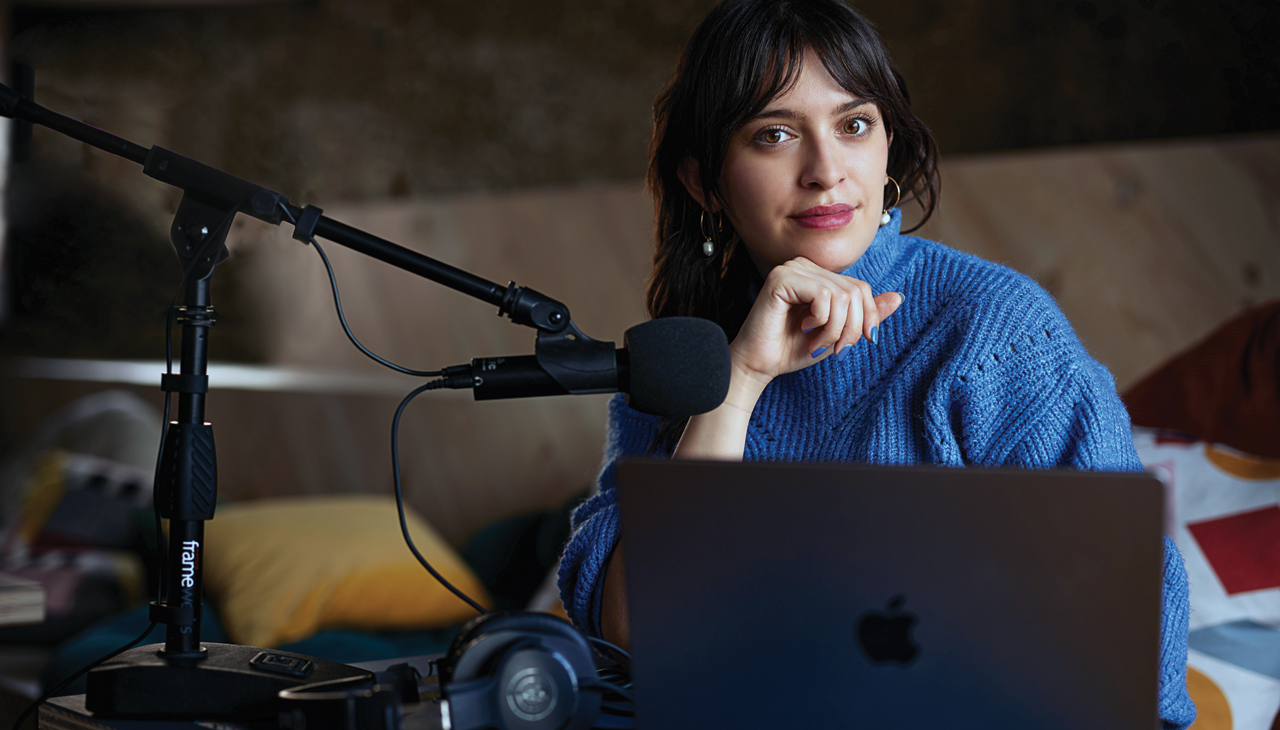
Fabiola Lara turns up the volume
Her Philly-based podcast 'Draws in Spanish' highlights stories of Latino graphic artists around the U.S.
“He who seeks finds.” How many of us have heard this popular saying from the sobering mouths of our grandparents, parents and closest friends? Probably most of us.
But this phrase is not always come true. Just ask Latin illustrator Fabiola Lara, an avid consumer of podcasts, which have boomed over the last 10 years.
According to Statistics, six out of 10 U.S. consumers over the age of 12 are hooked on a podcast. While the format is estimated to grow 37% in 2022, its popularity does not match its racial and cultural representation in the United States. Many of these people feel their cultural contribution to American society, over decades, is not reflected on these programs. Lara is one of the few changing that narrative.
{"preview_thumbnail":"/sites/default/files/styles/video_embed_wysiwyg_preview/public/video_thumbnails/-JkEVlnRQNU.jpg?itok=QSlvxp6h","video_url":"https://www.youtube.com/watch?v=-JkEVlnRQNU","settings":{"responsive":1,"width":"854","height":"480","autoplay":1},"settings_summary":["Embedded Video (Responsive, autoplaying)."]}
Art in the blood
She was born in Chile 29 years ago, and arrived in the state of Florida when she was only six months old. Fabiola studied advertising in college and then moved to New York to work in the art industry, which has always been part of her life. However, for a long time, her migration history has delayed the development of her innate talent.
“I grew up undocumented, it’s a big part of my identity as Latina. Although I have felt American since I was a child, I am only now officially American. I didn’t have papers, I didn’t have a Social Security Number, so being an immigrant and growing up in an undocumented family, the pressure was always to be a professional, to work in an office, to get ahead, and that’s not always related to being an artist. Your parents push you to be a doctor, a teacher, something more normal, common or respected. Being an artist is not so respected, because one thinks that artists suffer, that they don’t have a job, or a stable income. So there are not many immigrant artists,” Lara said in a conversation with AL DÍA from her house in Philadelphia.
According to Fabiola, family pressure to build a professional future in a promising field is different for first-generation immigrant youth.
“It’s not going to be so rare to be an artist if you are fifth generation because you already have a base, an established family and maybe other artists in your family. It’s different when you are first generation because you have to get ahead and take your parents’ efforts to another level. And, in that situation, being an artist is much more risky,” she said.
A socially-acceptable breakpoint
Following her instinct, and confident that a master’s degree in illustration was the perfect excuse to pave her way into the art world, Fabiola traveled to Barcelona in 2019.
“I was working in advertising, more specifically in social media, for various brands. I spent five years doing that. I really liked it, but it wasn’t my passion; it was fun, but it didn’t fascinate me. I realized I wanted to illustrate, so the master’s degree was my chance to get out of New York. It was hard for me to make the decision, so it was like ‘ok, I’m going to study,’ instead of quitting advertising overnight. Going to study abroad was socially accepted because 'you’re going to study' rather than 'quit your job,' she said.
Since then, she began to spending her time in illustration and graphic design. In 2020, she came back from Spain, moved to Pennsylvania, and began to receive her first editorial and commercial commissions. At the same time, she continued to feed her social media platforms, which are the true showcases of her skills and infinite creativity.
Her portfolio includes bilingual stickers designed for Instagram — which will remain active during the 2022 U.S. election year — a cartoon for the Los Angeles Times, in which she creates Chilean empanadas in her own vegan style, and the Love + Grit Philly Storefront Project, an exhibition in Philadelphia that turns empty spaces into artistic spaces.
Fabiola proudly talks about all of these works, but there is another project that hits at the heart of her Latin pride, to challenge herself and maintain her creative enthusiasm at 100%.
Draws in Spanish
"When I was a teenager, I saw immigrant artists, and this is why listening to the podcasts I noticed that these stories were missing. I want to represent those migrant experiences because being Latino in Latin America is different from being Latino in the United States, as it is another culture,” she says about her latest venture.
“I was listening to creative podcasts and it was always the same people, namely white American men. Thus, I felt there was a little bit of Latino representation missing. It seemed to me that everything was focused on artists who have big projects, more privileged backgrounds and a lot of education. It seemed to me that they were stories of established people, and I didn’t hear the stories of immigrant families in the podcasts,” Lara adds.
Tired of searching unsuccessfully for that Latin voice in podcasts and motivated by winning a scholarship awarded from the U.S. software company Adobe, she decided to create foundations for an idea that had been in her head for three years.
“I was applying for an Adobe Creator Residency and created the podcast for that application. When I saw what they required, I set up the whole application, what it was going to be about, who it was going to be aimed at, the format... They didn’t take that project, they didn’t accept it. So, I decided to hire a podcast consultant to help me launch the project, because I knew that doing it alone would have taken too long,” she explains.
RELATED CONTENT
What could have been a misstep became, thanks to a brave and shrewd vision, a new milestone in her career.
“When I saw the application, I said: 'This would be great! I can finally show my idea,’" she said
In October 2021, Draws in Spanish was born, a podcast that seeks to give visibility to Latino artists by exploring their creative journeys.
“At the beginning I was a little nervous because you want to have enough people to interview, and there is always the fear of not having the next interviewee. But every time I interviewed one person, she would suggest one or two more, and I would also find one or two more on Instagram,” Fabiola says.
This initial uncertainty has dissipated over time and as the program began getting recognition. One of those to catch the wave has been Spotify, which chose one of the episodes of the podcast as one of the best of the week in the U.S. This, although it didn't come with any type of monetary compensation, allowed Draws in Spanish to conquer new audiences.
“It’s a project that I do with passion, I don’t make money with the podcast, it’s something I care a lot about and I’m doing it totally on my own. So anything helps me move forward with the show,” she said.
Energetic and lively, Fabiola looks back on these last nine months. She feels more confident, because the production of the program helped her to value herself.
“I know how I want to execute my plan, but I have to trust my creative ideas more. I had this idea years ago, but until I put it in a PDF for Adobe I didn’t do it. I could have done it a long time ago, but I didn’t because I had a lot of doubts... but those doubts disappear when you get down to work,” she says.
Speaking in English, drawing in Spanish
“If you interview Latinos, why don’t you speak in Spanish?” is a question Fabiola has had to answer more than once.
“For me it’s more difficult to have an interview in Spanish because I interview Latino artists in the United States, and many of them don’t handle Spanish very well. I’m not against doing it because I would love to practice my Spanish more and I would love to have the podcast for a Spanish-speaking audience, but for now it would be having two shows because you can’t translate an interview from English to Spanish that easily. And another important thing is that I have people listening to me in Japan, in Indonesia… English is more international. I would love one day to have many episodes in Spanish or a video podcast with translations. That would be more realistic,” she said.
The first season of Draws in Spanish broadcast 18 episodes on Spotify and Apple Podcasts. Currently, the host is preparing for a second season, which will premiere in August and will be funded in part by the Podcash program for independent podcasters.
“I’m selecting different artists, preparing different questions and recharging energy because it also takes a lot of time to create a podcast. Even if it’s not a visual thing, it demands a lot from me,” she concludes.











LEAVE A COMMENT: